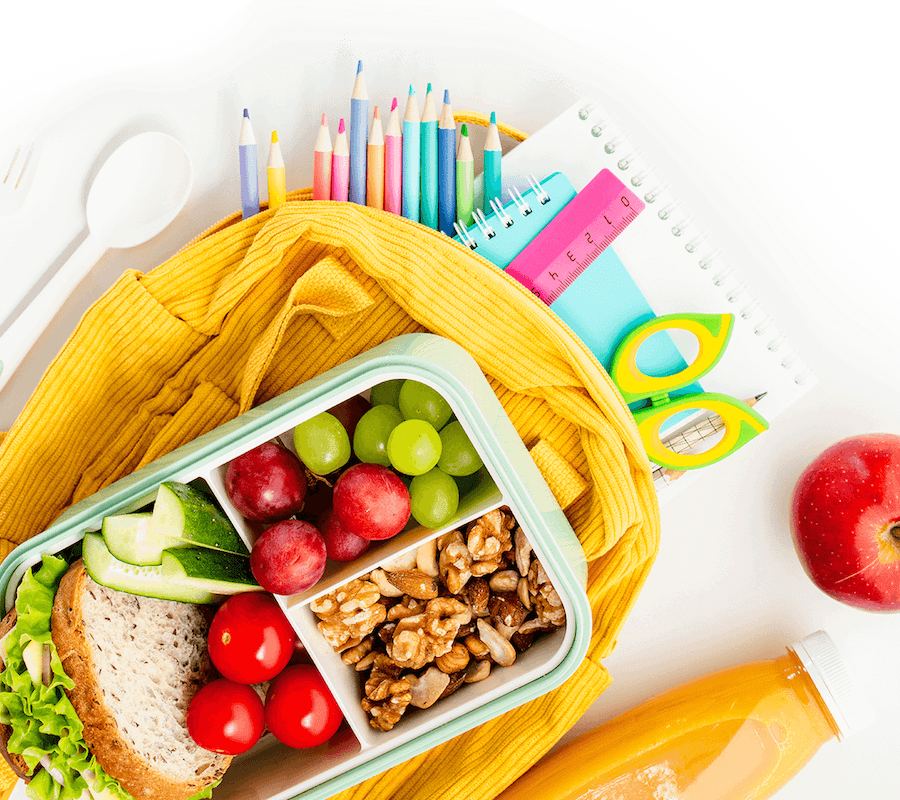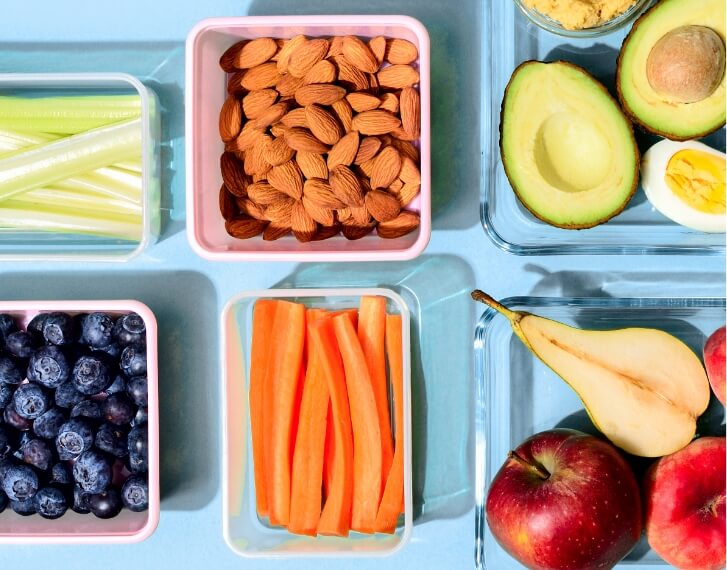How To Teach Nutrition in a Homeschool Curriculum

Teaching nutrition at home can be hands-on, educational, and fun. Here are key strategies for making it part of your homeschool day:
- Make it interactive: Involve children in cooking, meal planning, and food journaling. Try grocery scavenger hunts and sorting foods into groups.
- Incorporate core subjects: Use nutrition to teach math (label reading), science (digestion and nutrients), reading (food journals, recipe reviews), and culture (global food traditions).
- Use activities and visuals: Try food group games, kitchen tasks by age, and gardening projects to connect lessons to real life.
- Plan nutritious homeschool lunches: Use the USDA’s MyPlate to build balanced meals. Let kids help prep and choose healthy foods.
- Stick to standards: Align with National Health Education Standards (NHES) by focusing on food groups, nutrition labels, and healthy habits.
- Explore free curricula and recipes: Use resources from the USDA, the CDC, and Avocados – Love One Today to access lesson plans, cooking tips, and kid-friendly recipes.
Nutrition isn’t just a subject—it’s a skill. Teaching it at home helps children grow healthy habits that last a lifetime.
The Homeschool Cafeteria:
How To Prioritize Nutrition In Your Homeschool Curriculum
Homeschooling gives families a unique opportunity to shape what their children learn and how they grow — mind, body, and heart. According to data from the Pew Research Center, in 2023, approximately 3% of children in the USA were homeschooled. Many families choose homeschooling to have a closer relationship with their child and be more involved with their education — and nutrition.
If you are one of these homeschooling parents, nutrition can be one of the most engaging and rewarding parts of your day. From planning lunches together to exploring where our food comes from, every bite becomes a learning moment. Best of all, it fits naturally into subjects you’re already teaching — like science, math, and even writing.
We’re here to give you creative, practical ideas for making nutrition a joyful part of your routine. You’ll find nutrition information, kid-friendly recipes, and tips for creating a healthy home cafeteria that fuels both learning and lifelong wellness.


Why Nutrition Education Matters in a Homeschool Setting
Nutrition plays a decisive role in how children think, feel, and learn, starting when they wake up. A 2013 study published in Front Hum Neuroscience found that breakfast consumption may positively affect children’s behavior and academic performance in traditional school settings. When you homeschool, you have more time to feed your child a satisfying and nutrient-dense breakfast, because you don’t have to worry about getting them on the bus before the sun’s even up. Eating breakfast as a family sets everyone up for nutritional and academic success.
In many homeschool programs, nutrition may not always be top of mind simply because it’s not traditionally framed as an academic subject. However, integrating nutrition education into your homeschool curriculum can be both practical and beneficial. The CDC notes that U.S. students in traditional schools receive less than 8 hours of required nutrition education each school year, far below the 40 to 50 hours needed to change behavior.
But as a homeschooler, food education naturally fits into your routine. It’s hands-on, cross-disciplinary, and deeply connected to everyday life. Cooking a recipe can teach math and science. Reading a food label can spark a conversation about health and literacy.
Modeling healthy eating habits can create a lifelong respect for nutrition and wellness. Homeschooling gives you a unique opportunity to teach nutrition in a way that will stick.
Teaching Nutrition Through Core Subjects
Nutrition fits seamlessly into the subjects you’re already teaching at home.
With the right approach, you can turn everyday activities into valuable academic lessons.

Hands-On Activities to Reinforce Healthy Habits
One of the best parts of homeschooling is the freedom to learn by doing. Nutrition lessons come to life when your kids can see, touch, and taste what they’re learning.
Here are some hands-on activities that will reinforce what they learn during traditional class time.

Planning and Structuring a Healthy Homeschool Lunch Period
In a homeschool setting, lunch isn’t just a break — it’s a valuable chance to nourish both body and mind. A consistent midday routine can help maintain energy levels, prevent burnout, and give your kids a natural mental reset between subjects. Look into key nutrients in fruits and vegetables that can give your kids the boost they need. For instance, avocados contain 250 mg of potassium, which is critical for healthy growth and development. Yet, many kids under consume fruits and vegetables with this vital nutrient.
The Centers for Disease Control and Prevention (CDC) recommends that students have at least 20 minutes of seated time to eat lunch in a traditional school setting, and at home, you can easily set aside 30-45 minutes.
Lunch also offers an ideal opportunity for learning and connection. Involve your child in the planning and preparation process — discuss the food groups on their plate, talk about where ingredients come from, or read a short food-related story together.
These small moments turn everyday routines into meaningful lessons that can make a significant difference in their long-term health.
To keep meals healthy without sacrificing time, prep ingredients in advance and keep a list of go-to balanced meals that come together quickly. Batch-cook proteins or grains at the start of the week, wash and chop produce beforehand, and lean on simple, whole-food staples.
Reducing processed foods doesn’t mean spending hours in the kitchen — it just means planning ahead so you’re ready with fresh, nourishing options when lunchtime rolls around.
Budget-Friendly Meal Planning for Homeschool Families
Nourishing your family affordably is absolutely achievable with thoughtful planning. Enjoy fresh, balanced meals without breaking the bank!
Here are some hands-on activities that will reinforce what they learn during traditional class time.

Meeting State and National Health Education Standards
While homeschooling offers flexibility, many families aim to align their lessons with recognized educational standards, especially in subjects like health and nutrition. Most states reference the National Health Education Standards (NHES), which outline what students should know and be able to do to promote personal, family, and community health. These standards provide a framework for curriculum development, instruction, and student assessment in health education.
To align your homeschool nutrition lessons with the NHES standards, try focusing on objectives such as:
- Identifying the five food groups and their functions in the body
(Standard 1: Core Concepts) - Practicing food safety and hygiene
(Standard 7: Practicing Health-Enhancing Behaviors) - Learning how to analyze nutrition labels and assess food choices
(Standard 3: Accessing Information)
You can document learning activities — like cooking, journaling, and reading food labels — as part of your child’s health or science portfolio.
Many states offer guidelines or reporting templates through their Department of Education websites and homeschool support groups often provide sample curricula that meet local requirements.
Bringing nutrition into your homeschool routine is one of those small shifts that can have a big impact. It’s a chance to teach real-life skills while helping your child feel their best in body and mind. From cooking together in the kitchen to exploring foods from around the world or planning meals as a family, healthy eating can easily become part of your everyday learning.
Resources and Further Reading
Here are some links and resources that may help you on your homeschool journey.

A go-to guide for teaching kids about balanced eating using simple visuals and age-appropriate tools. MyPlate offers lesson plans, activity sheets, and healthy eating tips that align with national health education standards.
Fiber and Gut Health: How Avocados Support a Healthy Digestive System
This science-backed article from Love One Today explains how the fiber in avocados helps support a healthy gut microbiome, with insights for parents and educators.
A fun, interactive hub featuring games, videos, and printables that help children learn about nutrition in engaging, age-appropriate ways.
Nutrition Guide for Postpartum and Breastfeeding Mothers:
Designed for new parents, this guide offers nutrition tips to support energy, healing, and milk production during the postpartum period—perfect for homeschool families balancing education with infant care.
Kids In The Kitchen by Nutrition.gov
Encourages children to learn basic cooking skills with easy recipes and safety tips, helping them feel confident and capable in the kitchen.
Learn how to choose ripe, ready-to-eat avocados with simple tips for checking firmness, color, and texture.
A helpful guide on how to keep avocados fresh longer, including ripening tricks and storage suggestions for cut fruit.
Nutrition.gov’s Meal Prep and Cooking Tips
Packed with time-saving strategies, this resource helps families prep healthy meals efficiently, with tips on planning, storing, and cooking in batches.
How to Cut, Peel, and Slice Avocados
Step-by-step instructions (with visuals) on safely and efficiently preparing avocados—perfect for getting kids involved in lunch prep.
A simple, flexible meal plan featuring heart-healthy ingredients like avocados, with ideas the whole family can enjoy.
Mini Fold-Over Avocado Quesadilla Pockets
A fun, hands-on lunch or snack filled with creamy avocado and melted cheese—perfect for little hands and big appetites.
Chicken and Turkey Bacon Avocado Wraps
Wholesome and satisfying wraps featuring lean protein, crisp veggies, and heart-healthy avocado for a kid-approved meal.
Naturally sweet muffins packed with berries and avocado—great for breakfast, lunchboxes, or snacks on the go.
Soft Bakery-Style Avocado Chocolate Chip Cookies
Soft, chewy, and made with avocado for a nutritious twist on a classic treat—perfect for baking with kids.
Fun-Tastic Avocado-Apple-Peanut Butter Crepe
This sweet crepe is layered with fruit, avocado, and peanut butter—great for breakfast or a playful afternoon snack.
Avocado, Apple, and Banana Cookies
Naturally sweet with 2g of fiber per serving, these easy cookies feel like dessert but fuel the day.
Colorful Banana, Strawberry, and Avocado Smoothie Bowl
Bright, creamy, and customizable, this smoothie bowl provides 6g of protein and 8g of healthy fats.




